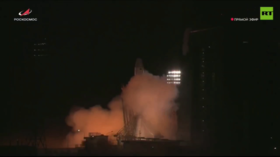BBC airs Maidan fighter admitting he fired on police before Kiev massacre
Nearly a year after the massacre on Kiev's Maidan left over 50 dead, the BBC has aired footage of an opposition fighter who says he fired at police in the early morning that day, bringing into question the popular narrative that riot police fired first.
READ MORE: Reuters investigation exposes ‘serious flaws’ in Maidan massacre probe
"I was shooting downward at their feet," says a man the broadcaster decided to identify as Sergei.
"Of course, I could have hit them in the arm or anywhere. But I didn't shoot to kill."
According to Sergei, he took up a position in the Kiev Conservatory, a music academy located on the southwest corner of Kiev’s Independence Square, on February 20.
One day prior, he had met up with a man who offered him two guns. The first was a 12-gauge shotgun, while the other was a hunting rifle – a Saiga that fired high-velocity rounds.
He chose the Saiga and hid it at a post office that, along with the conservatory, was under the protesters’ control. Sergei told the BBC he was later escorted to the Conservatory, where, with a second gunman, he spent 20 minutes before 7:00 am firing on police.
Other witness testimony has corroborated his account.
Andriy Shevchenko, who was an opposition MP at the time and also part of the Maidan movement, said he had received a phone call from the head of the riot police on Maidan Square claiming his officers had come under fire.
"He calls me and says, 'Andriy, somebody is shooting at my guys.' And he said that the shooting was from the Conservatory," Shevchenko said.
Shevchenko, in turn, says he contacted Andriy Parubiy, who headed up security for the protesters and was known as the Commandant of Maidan.
It’s at this point where the details of what followed become murky.
Parubiy says he sent a group of “his best men” to scour the Conservatory and determine if anyone was firing from it. Parubiy, who now serves as deputy speaker in the current Ukrainian parliament, claims his men found no gunmen in the building.
A photographer who had gained access to the Conservatory later in the morning just after 8:00 am, however, took pictures of men with guns in the building, though he never saw them discharge their weapons.
READ MORE: Kiev snipers hired by Maidan leaders - leaked EU's Ashton phone tape
All the while, Shevchenko claims he was getting increasingly panicked calls from the head of the riot police, who said that five officers had been wounded and another killed before he decided to pull out.
Sergei's account appears to contradict Parubiy’s.
"I was just reloading," Sergei told the BBC. "They ran up to me and one put his foot on top of me, and said, 'They want a word with you, everything is OK, but stop doing what you're doing.'"

Sergei says he was convinced the men who dragged him away were from Parubiy’s security unit, though he admits he did not recognize their faces. After being taken out of the building, he was dropped off outside of Kiev by car, though it appears no further harm came to him.
By this point, the BBC notes that three policemen had been wounded fatally and the mass killings began that ultimately left more than 50 protesters dead.
Snipers on Maidan: unsolved mystery
February 20 was the bloodiest day of protests since they started in November 2013, and the bloodshed ultimately led to the ouster of Ukrainian President Viktor Yanukovich. Both sides have blamed each other for being behind the sniper fire that brought the Euromaidan revolution to a head.
RT's Aleksey Yaroshevsky, who was reporting form the scene that day, came under fire from unidentified gunmen at the time.
Witnesses at the time said they saw snipers shooting at both protesters and security forces.
A leaked recording of a conversation between European Union foreign policy Baroness Catherine Ashton and Estonia’s foreign minister, Urmas Paet, also appeared to confirm the possibly that it had been members of the opposition, and not Yanukovich’s security forces, who fired the first shots.
“There is a stronger and stronger understanding that behind the snipers – it was not Yanukovich, it was somebody from the new [ruling] coalition,”Paet told Ashton, citing claims that “there were the same snipers killing people from both sides.”
Ukraine’s former State Security chief, Oleksandr Yakymenko, would also blame Ukraine's current Euromaidan government, saying they hired the snipers who precipitated violence on the square.
The protest leaders, many of whom hold positions in the current Ukrainian government, insist that Yanukovich and his security forces bear full responsibility for the shootings.
In April, almost two months after the shooting, Ukrainian prosecutors arrested several Berkut riot police officers as possible “Maidan snipers.”
The investigation, however, seems to have ended there.
In October, Reuters published the results of its examination, which analyzed Kiev’s probe into February’s Maidan shootings.
The news agency’s reporters uncovered “serious flaws” in the case against Berkut officers. Dozens of families of Maidan victims are still demanding "an objective and accurate investigation."












